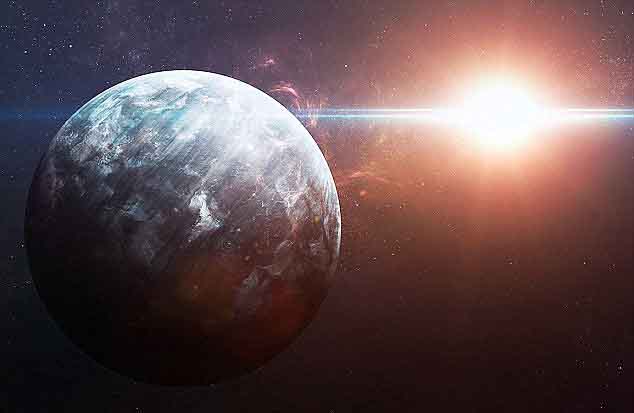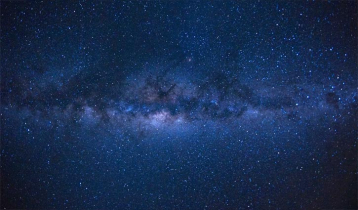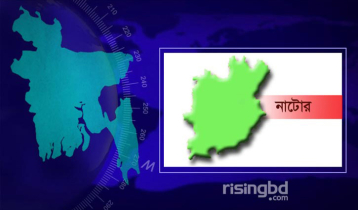Planet Nine could be a ‘rogue world’
4 || risingbd.com

Risingbd Desk: It has captured the imagination of astronomers and sci-fi fans alike - and could turn out to be a real rogue world.
Dubbed Planet Nine, the elusive world is believed by many to be responsible for the strange shaped orbits of objects in the outer realms of the solar system, but it is yet to be seen.
Now, a new theory claims it could be even odder than first thought.
Researchers at New Mexico State University (NMSU) say it could have once been a 'rogue planet, and may have been captured by our solar system.
'It is very plausible' that Planet Nine is a captured rogue, a world that cruises through space unattached to a star, James Vesper, an undergraduate at New Mexico State University (NMSU), said during a news conference at the 229th meeting of the American Astronomical Society in Grapevine, Texas.
Vesper and his mentor, NMSU math and physical science professor Paul Mason, performed simulations of 156 encounters between our solar system and rogue planets of various sizes and trajectories, according to Space.com.
'Rogue, or free-floating, planets may be abundant in the Galaxy,' he wrote in a paper accompanying the talk.
'Several have been observed in the solar neighborhood.
'They have been predicted to even outnumber stars by a large fraction, and may partially account for dark matter in the disk of the galaxy, as the result of circumbinary planet formation.
'We speculate that if rogue planets are abundant as predicted, then, Planet 9 may be a captured rogue.'
The simulations revealed in about 60 percent of the encounters, the incoming rogue planet would be flung out of the solar system.
In about 10 percent of all cases, the rogue would take at least one of our solar system's native planets with it as it departed, he added.
However, in about 40 percent of the encounters, the rogue would end up being captured by the solar system.
This could happen via a 'soft capture,' in which no native planets are ejected, or the invader could boot one or more worlds out as it came in, Vesper said; it would depend on the rogue's characteristics.
The simulations also suggest that our solar system has likely never had an encounter with a rogue world more massive than Neptune, Vesper added.
Astronomers could discover the solar system's mystery ninth planet by 2019, scientists have claimed.
But with up to 10 research groups scouring the skies, astronomers believe it won't remain hidden for long and could be discovered in the next 16 months.
The claims were made by astronomer Mike Brown, one of those who proposed the existence of the mystery world, while speaking at a conference in the US this week.
'I'm pretty sure, I think, that by the end of next winter – not this winter, next winter – I think that there'll be enough people looking for it that … somebody's actually going to track this down,' said Professor Brown, speaking at a meeting of the American Astronomical Society's Division for Planetary Sciences (DPS) in Pasadena.
The mystery world was first proposed by Professor Brown's team to account for the long elliptical orbit of frigid objects in the extending out beyond the Kuiper belt past Pluto – whose planetary status was in part killed off by Professor Brown's team at the California Institute of Technology (CalTech) in Pasadena.
But with a number of research groups dedicated to finding evidence of the planet and some of the world's most advanced telescopes could help pinpoint it in the night sky, potentially before the next DPS conference.
The discovery would mark 'a pretty quick turnaround' from hypothetical to confirmed planet, explains Space.com's Mike Wall, who reported the claims.
An increasing number of distant icy rocks have been found past Neptune – the last known official planet of the solar system – including Eris, which was discovered by the CalTech team and was the death blow for Pluto's planetary status, due to its larger size.
Among these trans-Neptunian ice worlds are a growing number like Sedna and L91, whose distorted orbits take them far out from the sun, taking thousands of years to make a single pass.
But as more of these objects have been discovered, their elongated paths points to a strong gravitational pull from a large object beyond Neptune – the theoretical Planet Nine.
Professor Brown and the Caltech team have proposed that in order to exert such a huge gravitational pull on these minor planets, Planet Nine would be around four times the size of Earth, ten times the mass and take between 10,000 and 20,000 years to orbit the sun.
According to Space.com, one of the reasons it has not yet been spotted is that it is currently at its furthest point from the sun on its epic planetary path, called its aphelion.
This could mean Planet Nine is currently 1,000 astronomical units (AU) from the sun – with 1 AU being the distance from Earth to the sun.
But tools such as the Subaru telescope in Hawaii and instruments at Japan's National Astronomical Observatory could be up to the task.
Professor Brown told reporters: 'There are a lot of people looking, and we are trying as hard as we can to tell people where to look. We want it to be found.'
Source: The Mail
risingbd/ Jan 12, 2017/Mukul
risingbd.com





































